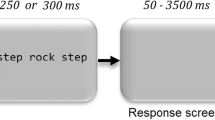Summary
Butler and Hains (1979) found individual differences in the effect of word length on RT in word naming and lexical-decision tasks; subjects scoring high on a vocabulary test were much less affected by word length than subjects with low scores. The present study attempted to determine whether such differences could be due to differences in the use of intraword structure, since word recognition has been linked, both empirically (Mason, 1978; Scheerer-Neumann, 1981) and theoretically (Mewhort & Campbell, 1981) to the use of orthographic redundancy. In Experiment 1, subjects were shown tachistoscopically presented letter strings varying in approximation to English. High vocabulary subjects were more capable of capitalizing on the redundancy with the higher-order approximations. Experiment 2 then established that performance on the vocabulary test was correlated with reading skill, measured by the Nelson-Denny Reading Test, and that skilled readers were more sensitive to the syllable structure in words. In the experiment, subjects were shown eight-letter words presented as three separate word units which either matched or violated syllable boundaries in the word. Skilled readers were more sensitive to the difference between syllable and nonsyllable units than were less skilled readers. The results obtained by Butler and Hains appear to reflect differences in reading skill and the efficiency of letter sequence parsing prior to word recognition.
Similar content being viewed by others
References
Anderson, I.H., & Dearborn, W.F. (1952). The Psychology of Teaching Reading. New York: Ronald Press.
Brown, J.I. (1900). The Nelson-Denny Reading Test. Boston: Houghton-Mifflin.
Butler, B.E. (1979). A note on familiarity and scanning with tachistoscopic recognition. Canadian Journal of Psychology, 33, 65–70.
Butler, B.E., & Hains, S. (1979). Individual differences in word recognition latency. Memory & Cognition, 7, 68–76.
Campbell, A.J., & Mewhort, D.J.K. (1980). On familiarity effects in visual information processing. Canadian Journal of Psychology, 34, 134–154.
Crosland, H.R. (1939). Superior elementary-school readers contrasted with inferior readers in letter position, range of attention scores. Journal of Educational Research, 22, 410–427.
Hirata, K., & Bryden, M.P. (1971). Tables of letter sequences varying in order of approximation to English. Psychonomic Science, 25, 322–324.
Hoffmann, J. (1927). Experimentell-psychologische Untersuchungen über Leseleistungen von Schulkindern. Archiv für die gesamte Psychologie, 58, 325–388.
Hunt, E. Mechanics of verbal ability. (1979). Psychological Review, 85, 109–130.
Jackson, M.D. (1980). Further evidence for a relationship between memory access and reading ability. Journal of Verbal Learning and Verbal Behaviour, 19, 683–694.
Jackson, M.D., & McClelland, J.L. (1974). Sensory and cognitive determinants of reading speed. Journal of Verbal Learning and Verbal Behavior, 14, 565–574.
Jackson, M.D., & McClelland, J.L. (1979). Processing determinants of reading speed. Journal of Experimental Psychology: General, 108, 151–181.
Just, M.A., & Carpenter, P.A. (1980). A theory of reading: From eye fixations to comprehensions. Psychological Review, 87, 329–354.
Kučera, H., & Francis, W.N. (1967). Computational Analysis of Present-day American English. Providence, R.I.: Brown University Press.
Mason, M. (1978). From print to sound in mature readers as a function of reader ability and two forms of orthographic regularity. Memory & Cognition, 6, 568–581.
Mason, M. (1980). Reading ability and the encoding of item and location information. Journal of Experimental Psychology: Human Perception and Performance, 6, 89–98.
Mason, M., Pilkington, C., & Brandau, R. (1981). From print to sound: reading ability and order information. Journal of Experimental Psychology: Human Perception and Performance, 7, 580–591.
Massaro, D.W., & Taylor, G.A. (1980). Reading ability and utilization of orthographic structure in reading. Journal of Educational Psychology, 72, 730–742.
Mewhort, D.J.K. (1978). DIS: an n-channel tachistoscope algorithm. Behavior Research Methods & instrumentation, 10, 756–760.
Mewhort, D.J.K., & Beal, A.L. (1977). Mechanisms of word identification. Journal of Experimental Psychology; Human Perception and Performance, 3, 629–640.
Mewhort, D.J.K., & Campbell, A.J. (1981). Toward a model of skilled reading: An analysis of performance in tachistoscopic tasks. In E. MacKinnon & T.G. Waller (Eds.), Reading Research: Advances in Theory and Practice, Vol. 3. New York: Academic Press.
Perfetti, C.A., Finger, E., & Hogaboam, T. (1978). Sources of vocalization latency differences between skilled and less skilled young readers. Journal of Educational Psychology, 70, 730–739.
Perfetti, C.A., Goldman, S., & Hogaboam, T.W. (1979). Reading skill and the identification of words in discourse context. Memory & Cognition, 7, 273–282.
Perfetti, C.A., & Hogaboam, T. (1975). The relationship between single word decoding and reading comprehension skill. Journal of Educational Psychology, 67, 461–469.
Scheeren, E. (1972) Order of report and order of scanning in tachistoscopic recognition. Canadian Journal of Psychology, 26, 382–390.
Scheerer, E. (1973). A further test of the scanning hypothesis in tachistoscopic recognition. Canadian Journal of Psychology, 27, 95–102.
Scheerer-Neumann, G. (1981). The utilization of intraword structure in poor readers: Experimental evidence and a training program. Psychological Research, 43, 155–178.
Taft, M. (1979). Lexical access via an orthographic code: The basic orthographic syllabic structure (BOSS). Journal of Verbal Learning and Verbal Behavior, 18, 21–29.
Taylor, I., & Taylor, M.M. (1983). The Psychology of Reading. New York: Academic Press.
Thibadeau, R., Just, M.A., & Carpenter, P.A. (1982). A model of the time course and content of reading. Cognitive Science, 6, 157–203.
Tramer, O., Butler, B.E., & Mewhort, D.J.K. (in press). Evidence for scanning with unilateral visual presentation of letters. Brain and Language.
Author information
Authors and Affiliations
Rights and permissions
About this article
Cite this article
Butler, B.E., Jared, D. & Hains, S. Reading skill and the use of orthographic knowledge by Mature Readers. Psychol. Res 46, 337–353 (1984). https://doi.org/10.1007/BF00309068
Received:
Issue Date:
DOI: https://doi.org/10.1007/BF00309068



